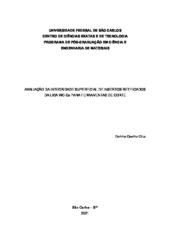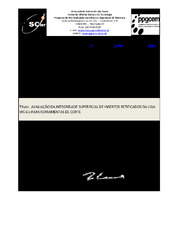| dc.contributor.author | Cruz, Dennis Coelho | |
| dc.date.accessioned | 2021-06-24T11:05:32Z | |
| dc.date.available | 2021-06-24T11:05:32Z | |
| dc.date.issued | 2021-05-11 | |
| dc.identifier.citation | CRUZ, Dennis Coelho. Avaliação da integridade superficial de insertos retificados da liga WC-Co para ferramentas de corte. 2021. Tese (Doutorado em Ciência e Engenharia de Materiais) – Universidade Federal de São Carlos, São Carlos, 2021. Disponível em: https://repositorio.ufscar.br/handle/ufscar/14417. | * |
| dc.identifier.uri | https://repositorio.ufscar.br/handle/ufscar/14417 | |
| dc.description.abstract | Cutting tools produced from cobalt tungsten carbide alloy (WC-Co),
compared to conventional cutting tools, provide lower cost of machining, with
increasing productivity and acceptable combination of hardness and fracture
toughness. Due to the high value of hardness, the finished product after sintering
is obtained by grinding process, which produces high thermal and mechanical
loads. However, this process may change the surface characteristics, which
affect the cutting insert performance during the application in the machining
process. In this context, the present work evaluates the influence of the grinding
process variables on the surface integrity of carbide inserts and, consequently,
on the tool life in service, in this case, the orthogonal turning of a nodular cast
iron. The effects of different conditions of the grinding process were observed
(cutting and axial feed speeds, dressing axial speed, diamond grinding wheel of
different grain size and bonding material) on the surface roughness (Rz) and
edge roughness (∆r), variation in hardness in relation to that of the base material
(∆HK) and residual stress in the perpendicular direction to the grinding (σ) of the
cemented tungsten carbide cutting inserts. As main results, it was verified that
the use of the grinding wheel with smaller grain size (D15) and the use of resinoid
binder improved the achievement of lower values of Rz and ∆r, with the
consequent generation of more regular surfaces and edges. Higher compressive
residual stress and higher hardness in the surface were found after grinding with
a vitrified binder wheel and larger grain size (D46). The compressive residual
stress e high hardness contributed to increase of the insert ́s life in turning
experiments, due to the formation of crack by mechanical effort determining factor
for the end of tool life. | eng |
| dc.description.sponsorship | Não recebi financiamento | por |
| dc.language.iso | por | por |
| dc.publisher | Universidade Federal de São Carlos | por |
| dc.rights | Attribution-NonCommercial-NoDerivs 3.0 Brazil | * |
| dc.rights.uri | http://creativecommons.org/licenses/by-nc-nd/3.0/br/ | * |
| dc.subject | Retificação | por |
| dc.subject | Metal duro | por |
| dc.subject | Inserto de corte | por |
| dc.subject | Integridade superficial | por |
| dc.subject | Grinding | eng |
| dc.subject | Hard metal | eng |
| dc.subject | Cutting insert | eng |
| dc.subject | Surface integrity | eng |
| dc.title | Avaliação da integridade superficial de insertos retificados da liga WC-Co para ferramentas de corte | por |
| dc.title.alternative | Evaluation of the surface integrity of ground cemented tungsten carbide cutting inserts | eng |
| dc.type | Tese | por |
| dc.contributor.advisor1 | Sordi, Vitor Luiz | |
| dc.contributor.advisor1Lattes | http://lattes.cnpq.br/8364164402481940 | por |
| dc.contributor.advisor-co1 | Ventura, Carlos Eiji Hirata | |
| dc.contributor.advisor-co1Lattes | http://lattes.cnpq.br/1689198421096127 | por |
| dc.description.resumo | As ferramentas de corte produzidas com as ligas de carbeto de tungstênio
e cobalto (WC-Co), em comparação com ferramentas de corte convencionais,
propiciam menores custos de usinagem, ganhos de produtividade e boa
combinação entre dureza e tenacidade à fratura. Devido aos elevados valores de
dureza, seu acabamento após a sinterização é realizado por processo de
retificação, o qual produz elevadas cargas térmicas e mecânicas e causa
alteração das características superficiais, as quais afetam o desempenho da
ferramenta durante a sua aplicação em processo de usinagem. Neste contexto,
o presente trabalho avalia a influência das variáveis do processo de retificação
sobre a integridade superficial de insertos de metal duro e, consequentemente,
sobre a vida da ferramenta em serviço, no caso, o torneamento ortogonal de um
ferro fundido nodular. Foram observados os efeitos de diferentes condições do
processo de retificação (velocidade de corte e avanço, velocidade de avanço de
dressagem, tamanho do grão abrasivo e tipo de ligante do rebolo
diamantado) sobre a rugosidade superficial (Rz) e de aresta (∆r), a variação da
dureza em relação à do material base (∆HK) e a tensão residual na direção
perpendicular à de retificação (σ) dos insertos de metal duro. Como resultados
principais, verificou-se que a aplicação do rebolo com menor tamanho de grão
(D15) e ligante resinoide favoreceu a apresentar os menores valores de Rz e ∆r,
com a consequente geração de superfícies e arestas mais regulares. Já tensões
residuais mais compressivas e maiores durezas na superfície do inserto foram
geradas após a retificação com rebolo de ligante vitrificado e maior tamanho de
grão (D46). A tensão residual compressiva e a alta dureza contribuíram para o
aumento da vida do inserto nos testes de torneamento, sendo a formação de
trinca por esforço mecânico o fator determinante para o fim de vida da
ferramenta. | por |
| dc.publisher.initials | UFSCar | por |
| dc.publisher.program | Programa de Pós-Graduação em Ciência e Engenharia de Materiais - PPGCEM | por |
| dc.subject.cnpq | ENGENHARIAS::ENGENHARIA DE MATERIAIS E METALURGICA::INSTALACOES E EQUIPAMENTOS METALURGICOS | por |
| dc.subject.cnpq | ENGENHARIAS::ENGENHARIA MECANICA::PROCESSOS DE FABRICACAO | por |
| dc.publisher.address | Câmpus São Carlos | por |
| dc.contributor.authorlattes | http://lattes.cnpq.br/1938053027300180 | por |


